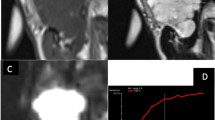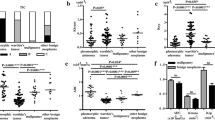Abstract
Purpose
Parotid pleomorphic adenomas present a risk of recurrence, higher when the tumour is a hypocellular subtype. The aim of the study was to determine whether it is possible to characterize this histological subtype with diffusion and perfusion sequences of the preoperative MRI.
Methods
This retrospective study included 97 patients operated between 2010 and 2020. Histologic slides review was performed to classify tumours into three histologic subtypes: hypocellular, classical and hypercellular. Univariate and multivariate analyses studied the correlation between histology and diffusion and perfusion MRI parameters obtained with OleaSphere® software.
Results
The hypocellular subtype had higher apparent diffusion coefficient values than the other two subtypes: 2.13 ± 0.23, 1.83 ± 0.42, and 1.61 ± 0.4 × 10–3 mm2/s for hypocellular, classical and hypercellular subtype respectively (p < 0.0001). Multivariate analysis showed that an ADCmean > 1.88 × 10–3 mm2/s was suggestive of a hypocellular pleomorphic adenoma in 79% of the cases, with a specificity and PPV of 94 and 96% (p < 0.001), respectively.
Conclusion
The histological subtype of a pleomorphic adenoma can be predicted preoperatively with ADC values. A prospective and multicentric study on a larger cohort is needed to confirm our results.





Similar content being viewed by others
Abbreviations
- PA:
-
Pleomorphic adenoma
- DCE-wi:
-
Dynamic contrast enhanced weighted imaging
- DWI:
-
Diffusion weighted imaging
- ROI:
-
Region of interest
- ADC:
-
Apparent diffusion coefficient
- b0, b100, b500, b1000:
-
Diffusion weighting factor b, where b = 0, 100, 500 or 1000 s/mm2
- Vp:
-
Plasma volume
- Ve:
-
Extracellular space volume
- k trans :
-
Transfer rate of contrast medium from plasma to extracellular extravascular space
- k ep :
-
Return transfer rate of the contrast medium from the extracellular extravascular space to the plasma
- Washin:
-
Slope of the rising part of the contrast uptake curve as a function of time
- Washout:
-
Rate of decrease of the contrast curve after it has reached its maximum, corresponding to the washout of the tissue studied
- Curve washout:
-
Percentage of the downward slope of the concentration curve as a function of time (washout of the contrast medium)
- AUC:
-
Area under the curve, or area under the concentration curve. Amount of contrast medium over the entire acquisition time
- Peak:
-
Maximum concentration of contrast medium reached during the acquisition
- Peak enhancement:
-
Peak enhancement percentage, or percentage increase in the initial slope of the concentration curve as a function of time
- TME:
-
Time to maximum enhancement. The time required to reach the maximum signal intensity, i.e. the maximum concentration of the contrast medium
References
Eveson JW, Cawson RA (1985) Salivary gland tumours: a review of 2410 cases with particular reference to histological types, site, age and sex distribution. J Pathol 146(1):51–58. https://doi.org/10.1002/path.1711460106
Spiro RH (1986) Salivary neoplasms: overview of a 35-year experience with 2807 patients. Head Neck Surg 8(3):177–184. https://doi.org/10.1002/hed.2890080309
Lin DT, Coppit GL, Burkey BB, Netterville JL (2004) Tumors of the accessory lobe of the parotid gland: a 10-year experience. Laryngoscope 114(9):1652–1655. https://doi.org/10.1097/00005537-200409000-00028
Batsakis JG (1984) Deep-lobe parotid gland tumors. Ann Otol Rhinol Laryngol 93(4 Pt 1):415–416
Renehan A, Neville Gleave E, McGurk M (1996) An analysis of the treatment of 114 patients with recurrent pleomorphic adenomas of the parotid gland. Am J Surg 172(6):710–714. https://doi.org/10.1016/S0002-9610(96)00293-0
McGregor AD, Burgoyne M, Tan KC (1988) Recurrent pleomorphic salivary adenoma—the relevance of age at first presentation. Br J Plast Surg 41(2):177–181. https://doi.org/10.1016/0007-1226(88)90048-3
Maran AGD, Mackenzie IJ, Stanley RE (1984) Recurrent pleomorphic adenomas of the parotid gland. Arch Otolaryngol Head Neck Surg 110(3):167–171. https://doi.org/10.1001/archotol.1984.00800290031007
Yamashita T, Tomoda K, Kumazawa T (1993) The usefulness of partial parotidectomy for benign parotid gland tumors a retrospective study of 306 cases. Acta Otolaryngol 113(sup500):113–116. https://doi.org/10.3109/00016489309126192
Paris J, Facon F, Pascal T, Chrestian MA, Moulin G, Zanaret M (2005) Preoperative diagnostic values of fine-needle cytology and MRI in parotid gland tumors. Eur Arch Otorhinolaryngol 262(1):27–31. https://doi.org/10.1007/s00405-003-0730-8
Christe A, Waldherr C, Hallett R, Zbaeren P, Thoeny H (2011) MR imaging of parotid tumors: typical lesion characteristics in MR imaging improve discrimination between benign and malignant disease. AJNR Am J Neuroradiol 32(7):1202–1207. https://doi.org/10.3174/ajnr.A2520
Yabuuchi H, Matsuo Y, Kamitani T et al (2008) Parotid gland tumors: can addition of diffusion-weighted MR imaging to dynamic contrast-enhanced MR imaging improve diagnostic accuracy in characterization? Radiology 249(3):909–916. https://doi.org/10.1148/radiol.2493072045
Espinoza S, Malinvaud D, Siauve N, Halimi P (2013) La perfusion en imagerie ORL. J Radiol Diagn Interv 94(12):1222–1237. https://doi.org/10.1016/j.jradio.2013.05.004
Habermann CR, Arndt C, Graessner J et al (2009) Diffusion-weighted echo-planar MR imaging of primary parotid gland tumors: is a prediction of different histologic subtypes possible? AJNR Am J Neuroradiol 30(3):591–596. https://doi.org/10.3174/ajnr.A1412
Yerli H, Agildere AM, Aydin E et al (2007) Value of apparent diffusion coefficient calculation in the differential diagnosis of parotid gland tumors. Acta Radiol. https://doi.org/10.1080/02841850701501717
Kikuchi M, Koyasu S, Shinohara S, Imai Y, Hino M, Naito Y (2016) Preoperative diagnostic strategy for parotid gland tumors using diffusion-weighted MRI and technetium-99m pertechnetate scintigraphy: a prospective study. PLoS ONE 11(2):e0148973. https://doi.org/10.1371/journal.pone.0148973
Witt RL (2002) The significance of the margin in parotid surgery for pleomorphic adenoma. Laryngoscope 112(12):2141–2154. https://doi.org/10.1097/00005537-200212000-00004
Dulguerov P, Todic J, Pusztaszeri M, Alotaibi NH (2017) Why do parotid pleomorphic adenomas recur? A systematic review of pathological and surgical variables. Front Surg 4:26. https://doi.org/10.3389/fsurg.2017.00026
Seifert G, Donath K (1976) Classification of the pathohistology of diseases of the salivary glands—review of 2600 cases in the salivary gland register. Beitr Pathol 159(1):1–32. https://doi.org/10.1016/S0005-8165(76)80013-3
Wang J, Takashima S, Takayama F et al (2001) Head and neck lesions: characterization with diffusion-weighted echo-planar MR imaging. Radiology 220(3):621–630. https://doi.org/10.1148/radiol.2202010063
Kato H, Kawaguchi M, Ando T, Mizuta K, Aoki M, Matsuo M (2018) Pleomorphic adenoma of salivary glands: common and uncommon CT and MR imaging features. Jpn J Radiol 36(8):463–471. https://doi.org/10.1007/s11604-018-0747-y
Stennert E, Guntinas-Lichius O, Klussmann JP, Arnold G (2001) Histopathology of pleomorphic adenoma in the parotid gland: a prospective unselected series of 100 cases. Laryngoscope 111(12):2195–2200. https://doi.org/10.1097/00005537-200112000-00024
Naeim F, Forsberg MI, Waisman J, Coulson WF (1976) Mixed tumors of the salivary glands: growth pattern and recurrence. Arch Pathol Lab Med 100(5):271–275
Paris J, Facon F, Chrestian MA, Giovanni A, Zanaret M (2004) Adénome pléomorphe parotidien. Annales d’Otolaryngologie et de Chirurgie Cervico-faciale 121(3):161–166. https://doi.org/10.1016/S0003-438X(04)95504-1
Chen L, Liu M, Bao J et al (2013) The correlation between apparent diffusion coefficient and tumor cellularity in patients: a meta-analysis. PLoS ONE 8(11):e79008. https://doi.org/10.1371/journal.pone.0079008
Chatterjee A, Watson G, Myint E, Sved P, McEntee M, Bourne R (2015) Changes in epithelium, stroma, and lumen space correlate more strongly with Gleason pattern and are stronger predictors of prostate ADC changes than cellularity metrics. Radiology 277(3):751–762. https://doi.org/10.1148/radiol.2015142414
Yabuuchi H, Kamitani T, Sagiyama K et al (2020) Characterization of parotid gland tumors: added value of permeability MR imaging to DWI and DCE-MRI. Eur Radiol 30(12):6402–6412. https://doi.org/10.1007/s00330-020-07004-3
Xu Z, Zheng S, Pan A, Cheng X, Gao M (2019) A multiparametric analysis based on DCE-MRI to improve the accuracy of parotid tumor discrimination. Eur J Nucl Med Mol Imaging 46(11):2228–2234. https://doi.org/10.1007/s00259-019-04447-9
Witt RL, Iacocca M (2012) Comparing capsule exposure using extracapsular dissection with partial superficial parotidectomy for pleomorphic adenoma. Am J Otolaryngol 33(5):581–584. https://doi.org/10.1016/j.amjoto.2012.03.004
Henriksson G, Westrin KM, Carlsöö B, Silfverswärd C (1998) Recurrent primary pleomorphic adenomas of salivary gland origin: intrasurgical rupture, histopathologic features, and pseudopodia. Cancer 82(4):617–620. https://doi.org/10.1002/(SICI)1097-0142(19980215)82:4%3c617::AID-CNCR1%3e3.0.CO;2-I
Park GC, Cho KJ, Kang J et al (2012) Relationship between histopathology of pleomorphic adenoma in the parotid gland and recurrence after superficial parotidectomy: histopathology in pleomorphic adenoma. J Surg Oncol 106(8):942–946. https://doi.org/10.1002/jso.23202
Li C, Xu Y, Zhang C et al (2014) Modified partial superficial parotidectomy versus conventional superficial parotidectomy improves treatment of pleomorphic adenoma of the parotid gland. Am J Surg 208(1):112–118. https://doi.org/10.1016/j.amjsurg.2013.08.036
Bär B, Mantsopoulos K, Iro H (2020) Paradigm shift in surgery for benign parotid tumors: 19 years of experience with almost 3000 cases. Laryngoscope 130(8):1941–1946. https://doi.org/10.1002/lary.28454
Riad MA, Abdel-Rahman H, Ezzat WF, Adly A, Dessouky O, Shehata M (2011) Variables related to recurrence of pleomorphic adenomas: outcome of parotid surgery in 182 cases. Laryngoscope 121(7):1467–1472. https://doi.org/10.1002/lary.21830
Wong DSY (2002) Frozen section during parotid surgery revisited: efficacy of its applications and changing trend of indications. Head Neck 24(2):191–197. https://doi.org/10.1002/hed.10072
Seethala RR, LiVolsi VA, Baloch ZW (2005) Relative accuracy of fine-needle aspiration and frozen section in the diagnosis of lesions of the parotid gland. Head Neck 27(3):217–223. https://doi.org/10.1002/hed.20142
Lambin P, Rios-Velazquez E, Leijenaar R et al (2012) Radiomics: extracting more information from medical images using advanced feature analysis. Eur J Cancer 48(4):441–446. https://doi.org/10.1016/j.ejca.2011.11.036
Author information
Authors and Affiliations
Corresponding author
Ethics declarations
Conflict of interests
The authors declare that they have no financial or non-financial interests that are directly or indirectly related to this work.
Additional information
Publisher's Note
Springer Nature remains neutral with regard to jurisdictional claims in published maps and institutional affiliations.
Rights and permissions
Springer Nature or its licensor (e.g. a society or other partner) holds exclusive rights to this article under a publishing agreement with the author(s) or other rightsholder(s); author self-archiving of the accepted manuscript version of this article is solely governed by the terms of such publishing agreement and applicable law.
About this article
Cite this article
Monestier, L., Del Grande, J., Haddad, R. et al. Correlation between MRI (DWI and DCE) and cellularity of parotid gland pleomorphic adenomas. Eur Arch Otorhinolaryngol 281, 2655–2665 (2024). https://doi.org/10.1007/s00405-024-08562-8
Received:
Accepted:
Published:
Issue Date:
DOI: https://doi.org/10.1007/s00405-024-08562-8




